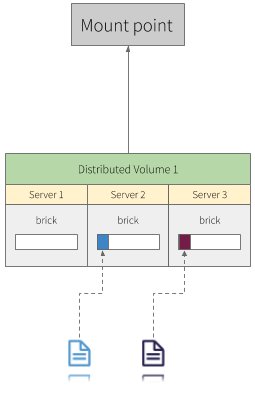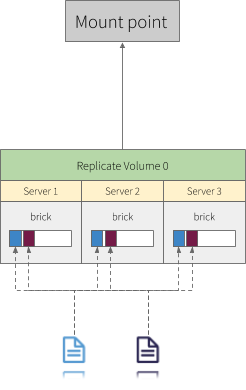How to setup storage GlusterFS
GlusterFS is a scalable network filesystem suitable for data-intensive tasks such as cloud storage and media streaming. GlusterFS is free and open source software and can utilize common off-the-shelf hardware.
Reference: https://docs.gluster.org/en/latest/Administrator%20Guide/GlusterFS%20Introduction/
Volume Types
Distributed
Distributed volumes distribute files across the bricks in the volume. You can use distributed volumes where the requirement is to scale storage and the redundancy is either not important or is provided by other hardware/software layers.

Replicated
Replicated volumes replicate files across bricks in the volume. You can use replicated volumes in environments where high-availability and high-reliability are critical.

Dispersed
Dispersed volumes are based on erasure codes, providing space-efficient protection against disk or server failures. It stores an encoded fragment of the original file to each brick in a way that only a subset of the fragments is needed to recover the original file (EC). The number of bricks that can be missing without losing access to data is configured by the administrator on volume creation time.

Erasure coding (EC)
It is a data protection and storage process through which a data object is separated into smaller components/fragments and each of those fragments is encoded with redundant data padding. EC transforms data object fragments into larger fragments and uses the primary data object identifier to recover each fragment.
Erasure coding is also known as forward error correction (FEC).
Erasure coding is primarily used in applications that have a low tolerance for data errors. This includes most data backup services and technologies including disk arrays, object-based cloud storage, archival storage and distributed data applications.
Reference: https://en.wikipedia.org/wiki/Erasure_code
Overview

How does this fit into Kubernetes
On-disk files in a Container are ephemeral, which presents some problems for non-trivial applications when running in Containers. First, when a Container crashes, kubelet will restart it, but the files will be lost - the Container starts with a clean state. Second, when running Containers together in a Pod it is often necessary to share files between those Containers. The Kubernetes Volume abstraction solves both of these problems.
Volumes
-
Filesystem: In Kubernetes, each container can read and write in its own filesystem. But the data written into this filesystem is destroyed when the container is restarted or removed.
-
Volume: Kubernetes has volumes. Volumes that are in a POD will exist as long as the POD exists. Volumes can be shared among the same POD containers. When a POD is restarted or removed the volume is destroyed.
-
Persistent Volume: The Kubernetes has persistent volumes. Persistent volumes are long-term stores within the Kubernetes cluster. Persistent volumes go beyond containers, PODs, and nodes, they exist as long as the Kubernetes cluster exists. A POD claims the use of a persistent volume for reading or writing or for reading and writing.
| Type | How long? |
|---|---|
| Filesystem | Container lifetime |
| Volume | Pod lifetime |
| Persistent Volume | Cluster lifetime |
Configure the cluster
Print the Join Command
-
Run the following commands to print the
joincommand master replicas on cluster:debian@busybox:~$ ssh kube-mast01 debian@kube-mast01:~$ sudo kubeadm token create --print-join-commandExpected output:
kubeadm join 192.168.4.20:6443 --token y5uii4.5myd468ieaavd0g6 --discovery-token-ca-cert-hash sha256:d4990d904f85ad8fb2d2bbb2e56b35a8cd0714092b40e3778209a0f1d4fa38b9
Running Commands in Parallel with tmux
Split panes horizontally
To split a pane horizontally, press ctrl+b and ‘ (single quotation mark). Let’s go!
debian@busybox:~$ tmux
debian@busybox:~$ ssh debian@glus-node01
ctrl+b"
debian@busybox:~$ ssh debian@glus-node02
ctrl+b"
debian@busybox:~$ ssh debian@glus-node03
ctrl+b"
Send commands to all panes
Press ctrl+b and shit+:, type the following command and hit ENTER:
setw synchronize-panes
-
Run the following command to join the Gluster nodes in the cluster using the join command printed in the previous section:
debian@busybox:~$ ssh kube-node01 debian@kube-node01:~$ sudo kubeadm join 192.168.4.20:6443 \ --token y5uii4.5myd468ieaavd0g6 \ --discovery-token-ca-cert-hash sha256:d4990d904f85ad8fb2d2bbb2e56b35a8cd0714092b40e3778209a0f1d4fa38b9 -
verify
debian@busybox:~$ kubectl get nodes -o wideExpected output:
NAME STATUS ROLES AGE VERSION INTERNAL-IP EXTERNAL-IP OS-IMAGE KERNEL-VERSION CONTAINER-RUNTIME glus-node01 Ready <none> 6m20s v1.15.6 192.168.3.87 <none> Debian GNU/Linux 9 (stretch) 4.9.0-12-amd64 docker://18.6.0 glus-node02 Ready <none> 6m7s v1.15.6 192.168.3.217 <none> Debian GNU/Linux 9 (stretch) 4.9.0-12-amd64 docker://18.6.0 glus-node03 Ready <none> 6m20s v1.15.6 192.168.3.240 <none> Debian GNU/Linux 9 (stretch) 4.9.0-12-amd64 docker://18.6.0 kube-mast01 Ready master 29m v1.15.6 192.168.1.199 <none> Debian GNU/Linux 9 (stretch) 4.9.0-12-amd64 docker://18.6.0 kube-mast02 Ready master 22m v1.15.6 192.168.1.214 <none> Debian GNU/Linux 9 (stretch) 4.9.0-12-amd64 docker://18.6.0 kube-mast03 Ready master 22m v1.15.6 192.168.1.207 <none> Debian GNU/Linux 9 (stretch) 4.9.0-12-amd64 docker://18.6.0 kube-node01 Ready <none> 18m v1.15.6 192.168.2.211 <none> Debian GNU/Linux 9 (stretch) 4.9.0-12-amd64 docker://18.6.0 kube-node02 Ready <none> 18m v1.15.6 192.168.2.144 <none> Debian GNU/Linux 9 (stretch) 4.9.0-12-amd64 docker://18.6.0 kube-node03 Ready <none> 18m v1.15.6 192.168.2.251 <none> Debian GNU/Linux 9 (stretch) 4.9.0-12-amd64 docker://18.6.0
Configuring Gluster store
-
Label K8 nodes
debian@busybox:~$ kubectl label nodes glus-node01 glus-node02 glus-node03 storagenode=glusterfsExpected output:
node/glus-node01 labeled node/glus-node02 labeled node/glus-node03 labeled -
Deploy glusterfs
debian@busybox:~$ kubectl create -f deploy/glusterfs-daemonset.yamlExpected output:
daemonset.extensions/glusterfs created -
Get pod IPs and peer probe glusterfs nodes
debian@busybox:~$ kubectl get pods -l glusterfs-node=pod -o wideExpected output:
NAME READY STATUS RESTARTS AGE IP NODE NOMINATED NODE READINESS GATES glusterfs-4kkz5 1/1 Running 0 4m47s 192.168.3.87 glus-node01 <none> <none> glusterfs-6blrz 1/1 Running 0 4m47s 192.168.3.217 glus-node02 <none> <none> glusterfs-jdqt9 1/1 Running 0 4m47s 192.168.3.240 glus-node03 <none> <none>debian@busybox:~$ kubectl exec -it glusterfs-4kkz5 -- gluster peer probe glus-node02.kube.demo peer probe: success. debian@busybox:~$ kubectl exec -it glusterfs-4kkz5 -- gluster peer probe glus-node03.kube.demo peer probe: success. -
Verify
debian@busybox:~$ kubectl exec -it glusterfs-4kkz5 -- gluster peer statusExpected output:
Number of Peers: 2 Hostname: glus-node02.kube.demo Uuid: 2ec26a67-8688-4313-8bcc-2ab03e9d4d2a State: Peer in Cluster (Connected) Hostname: glus-node03.kube.demo Uuid: b2f632f6-0c4f-4116-8f82-fcfcadba1170 State: Peer in Cluster (Connected) -
Create storage-class.yaml and deploy via kubectl
debian@busybox:~$ kubectl create -f deploy/storage-class.yamlExpected output:
storageclass.storage.k8s.io/glusterfs-simple created -
Verify
debian@busybox:~$ kubectl get storageclassExpected output:
NAME PROVISIONER AGE glusterfs-simple gluster.org/glusterfs-simple 65s -
Apply role based access control
debian@busybox:~$ kubectl create -f deploy/rbac.yamlExpected output:
serviceaccount/glfs-provisioner created clusterrole.rbac.authorization.k8s.io/glfs-provisioner-runner created clusterrolebinding.rbac.authorization.k8s.io/run-glfs-provisioner created -
Deploy Gluster provisioner
debian@busybox:~$ kubectl create -f deploy/provisioner.yamlExpected output:
deployment.extensions/glusterfs-simple-provisioner created -
Mark a Nodes unschedulable
debian@busybox:~$ kubectl cordon glus-node01 glus-node02 glus-node03Expected output:
node/glus-node01 cordoned node/glus-node02 cordoned node/glus-node03 cordonedVerify:
debian@busybox:~$ kubectl get nodes -l storagenode=glusterfs -o wideExpected output:
NAME STATUS ROLES AGE VERSION INTERNAL-IP EXTERNAL-IP OS-IMAGE KERNEL-VERSION CONTAINER-RUNTIME glus-node01 Ready,SchedulingDisabled <none> 31m v1.15.6 192.168.3.87 <none> Debian GNU/Linux 9 (stretch) 4.9.0-12-amd64 docker://18.6.0 glus-node02 Ready,SchedulingDisabled <none> 31m v1.15.6 192.168.3.217 <none> Debian GNU/Linux 9 (stretch) 4.9.0-12-amd64 docker://18.6.0 glus-node03 Ready,SchedulingDisabled <none> 31m v1.15.6 192.168.3.240 <none> Debian GNU/Linux 9 (stretch) 4.9.0-12-amd64 docker://18.6.0 -
Testing, create persistent volume claim
debian@busybox:~$ cat <<EOF | kubectl apply -f - kind: PersistentVolumeClaim apiVersion: v1 metadata: name: gluster-simple-claim annotations: volume.beta.kubernetes.io/storage-class: "glusterfs-simple" spec: accessModes: - ReadWriteMany resources: requests: storage: 10Gi EOFExpected output:
persistentvolumeclaim/gluster-simple-claim createdVerify
debian@busybox:~$ kubectl get pvc,pvExpected output:
NAME STATUS VOLUME CAPACITY ACCESS MODES STORAGECLASS AGE persistentvolumeclaim/gluster-simple-claim Bound pvc-48a419ff-299c-402b-88c0-9ac16342d321 10Gi RWX glusterfs-simple 7s NAME CAPACITY ACCESS MODES RECLAIM POLICY STATUS CLAIM STORAGECLASS REASON AGE persistentvolume/pvc-48a419ff-299c-402b-88c0-9ac16342d321 10Gi RWX Delete Bound default/gluster-simple-claim glusterfs-simple 2sClean up
debian@busybox:~$ kubectl delete pvc gluster-simple-claimExpected output:
persistentvolumeclaim "gluster-simple-claim" deletedCheck
debian@busybox:~$ kubectl get pvc,pvExpected output:
No resources found.